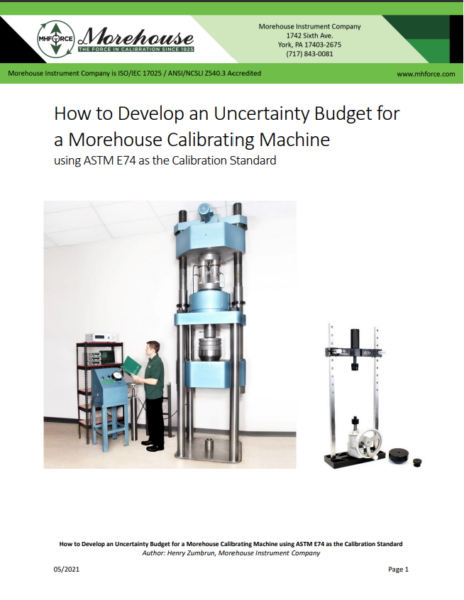How to Develop an Uncertainty Budget for a Morehouse Calibrated Machine
Uncertainty budgets are an essential part of any measurement. They help ensure calibrations are metrologically traceable, accurate, and reliable. Uncertainty budgets are also important for meeting regulatory requirements and accreditation.
This article provides insight into developing an uncertainty budget for a Morehouse-calibrated machine.
We will also discuss some specific tips for reducing the uncertainty of a Morehouse calibration.
Creating a measurement uncertainty budget involves several steps. Here's a general outline based on NIST SOP 29:
- Specify the Measurement Process. Define the measurand(s), the device being measured, and input quantities on which it depends.
- Identify and characterize the uncertainty sources. These include standard uncertainty from the measurement process, instrument precision (repeatability), resolution, environmental conditions, reproducibility of measurements, adapters, bias, unidentified errors, stability, operator error, the reference standard used to calibrate your device, etc.
- Quantify uncertainty components in applicable measurement units using Type A and Type B methods.
- Convert uncertainty components to standard uncertainties in units of the measurement result. This is the part many miss; if you are working in %, all uncertainty components need to be converted to %, working in lbf, then converting all units to lbf;
- Calculate the combined uncertainty. The combined standard uncertainty includes the standard uncertainty reported for the standards used, the standard uncertainty of the measurement process, the standard uncertainty from other sources, the standard uncertainty due to factors related to the measured item but unrelated to the measurement process, and finally, the standard uncertainty due to bias or differences.
- Expand the combined uncertainty using an appropriate coverage factor. This is where the effective degrees of freedom come in. The Guide to Uncertainty in Measurement recommends using the Welch-Satterthwaite equation to find the appropriate coverage factor for the confidence level desired.
- Evaluate the expanded uncertainty against appropriate tolerances, user requirements, and laboratory capabilities.
- Report correctly rounded uncertainties with associated measurement results.
Morehouse has developed a guidance document covering these steps in more detail. That document can be downloaded here.

Tips for Reducing the Uncertainty of a Morehouse Calibration:
- Use a reference standard with a low uncertainty.
- Use a load cell with a low uncertainty.
- Use a measurement system with a low uncertainty.
- Calibrate the load cell and the measurement system regularly.
- Train operators to follow proper calibration procedures.
- Use multiple load cells to cover the measurement range.
- Use a Best Existing Device (BED) for repeatability and reproducibility studies (often a Morehouse load cell calibrated by deadweight standards).
- Use a calibration machine that is plumb, level, square, and rigid with low torsion.
- Perform the calibration in a temperature-controlled environment.
- Use a high-quality indicator with a good resolution.
Uncertainty budgets are an essential part of any calibration process. Following the steps outlined in this blog post, you can develop an uncertainty budget.
When combined with the correct calibration interval to ensure reliability, measurement assurance techniques, such as setting up statistical process control charts and validating via an ILC or Proficiency Test, one can ensure that your calibrations are accurate and reliable.
Morehouse offers Interlaboratory comparison and proficiency testing.
--Henry Zumbrun, President of Morehouse Instrument Company
If you need help developing an uncertainty budget for your Morehouse-calibrated machine, please get in touch with us at Info@MHForce.com. Our team of experienced calibration engineers can help you with your calibration needs.
For more insights into force and torque calibration, metrology, and load cell reliability, explore our comprehensive blog here.
About Morehouse Instrument Company
Companies worldwide rely on Morehouse for accuracy and speed. The company turns around equipment in 7-10 business days so customers can return to work quickly and save money.
The York, PA-based company provides force and torque measurement products and services worldwide.
Morehouse Instrument Company, a trusted and accredited provider of force and torque measurement services for over 100 years, offers measurement uncertainties 10-50 times lower than the competition.
Morehouse helps commercial labs, government labs, and other organizations lower their measurement risk by lowering equipment uncertainties for torque and force measurement. Contact Morehouse at info@mhforce.com .
More Information about Morehouse
We believe in changing how people think about force and torque calibration in everything we do.
This includes setting expectations on load cell reliability and challenging the "just calibrate it" mentality by educating our customers on what matters and what causes significant errors.
We focus on reducing these errors and making our products simple and user-friendly.
This means your instruments will pass calibration more often and produce more precise measurements, giving you the confidence to focus on your business.
Companies around the globe rely on Morehouse for accuracy and speed.
Our measurement uncertainties are 10-50 times lower than the competition.
We turn around your equipment in 7-10 business days so you can return to work quickly, saving you money.
When you choose Morehouse, you're not just paying for a calibration service or a load cell.
You're investing in peace of mind, knowing your equipment is calibrated accurately and on time.
Contact Morehouse at info@mhforce.com to learn more about our calibration services and load cell products.
Email us if you ever want to chat or have questions about a blog.
We love talking about this stuff.
Our YouTube channel has videos on various force and torque calibration topics here.
# Uncertainty Budget


